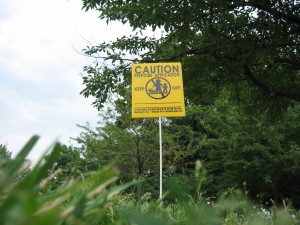11
Jun
Under Pressure EPA Denies Ohioâs Request to Use Restricted Pesticide
(Beyond Pesticide, June 11, 2010) The Environmental Protection Agency (EPA) has refused the state of Ohioâs request for an emergency exemption to use the restricted pesticide propoxur in residential settings for control of bed bugs, stating that the chemical âpresents unreasonable risk.” Propoxur is a highly toxic, broad spectrum insecticide. All indoor residential uses of this known neurotoxic chemical and possible carcinogen were voluntarily canceled in 2007. The Ohio Department of Agriculture, deeming the increases in bed bug infestations an emergency, requested an exemption to use propoxur in residential areas and in May the Ohio Senateâs Environment and Natural Resources Committee adopted a unanimous resolution urging the EPA to grant it. Beyond Pesticides, with coalition of environmental and public health groups, opposed the request and asked EPA to deny the exemption, citing the serious public health threat associated with the chemical, as well as the availability of alternatives.
EPA determined âthe requested use presents an unacceptable risk,â according to Administrator Lisa Jackson, in a letter to Ohio Governor Ted Strickland dated June 2, 2010. âAlthough EPA recognizes the severe and urgent challenges that Ohio is facing from bed bugs, the results of the risk assessment do not support the necessary safety findings as required by the Food Quality Protection Act (FQPA) and the Federal Insecticide, Fungicide, and Rodenticide Act (FIFRA). In particular, the requested use presents an unacceptable risk to children who might be exposed to propoxur in and around rooms treated for bed bugs,â Administrator Jackson went on to state.
Last November, Ohio requested an emergency exemption to use propoxur under Section 18, a controversial loophole in the Federal Insecticide Fungicide and Rodenticide Act (FIFRA), that allows for unregistered uses of a pesticide, and in many cases unregistered pesticides, under âemergency circumstances.â In a letter to Administrator Lisa Jackson, dated April 19, 2010, Ohio Governor Ted Strickland supported the stateâs request for the exemption claiming, âWithout the use of propoxur, there is very little that can be done to meaningfully stop the spread of bed bug infestations.â Environmental and public health groups, including Beyond Pesticides, petitioned EPA to deny the exemption.
Beyond Pesticides, in comments to EPA last December, stated that indoor uses of propoxur increase exposure and health risks of residents, especially children who are vulnerable. Beyond Pesticides also reminded the agency that propoxur should not be considered for a Section 18 exemption, since the pesticide was already canceled for indoor uses based on exposure concerns, and that the treatment of bed bugs is now routine, and cannot be considered an âemergencyâ as defined under FIFRA.
While bed bug populations have rebounded in recent years, due to growing resistance to widely used insecticides, relying on even more toxic chemical control is not a feasible option. Currently, EPA and other stakeholders are working to develop new methods of combating the surge in bed bug infestations, including increasing the role of integrated pest management (IPM), which according to the agency in their letter, âis an effective and environmentally sensitive approach to pest management that considers pest life cycles and relies on a combination of common-sense chemical and non-chemical solutions.â In April of 2009, EPA held the first ever National Bed Bug Summit to solicit recommendations from scientists, state and local officials, pest control operators and the general public on the best methods of control. EPA has also recently developed a website with information on controlling bed bugs that stresses IPM.
Propoxur is a carbamate insecticide first registered in the US in 1963 for the control of household pests such as ants, cockroaches, and bed bugs. It is also commonly used in flea and tick collars. Propoxur can be very dangerous to humans and the environment. Common symptoms of poisoning include malaise, muscle weakness, dizziness, and sweating. Headache, nausea, and diarrhea may also result. EPA considers propoxur a possible human carcinogen, while the state of California classifies it as a known human carcinogen. Propoxur is also highly toxic to beneficial insects such as honeybees as well as crustaceans, fish, and aquatic insects.
Columbus, Cleveland, and Cincinnati are among many cities in the United States, as well as cities worldwide, that saw a recent surge in bed bug infestations. According to a survey of pest control firms bed bug outbreaks have tripled since 2005. Infestations commonly occur in homeless shelters, and low income housing, as well as hospitals, college dorms, and hotels. Bed bugs are tiny insects up to Âź inches when full grown that usually live in cracks and crevices of bed frames and the seams of mattresses. Their bites result in sore spots or itchy welts usually found in a line, but bed bugs are not known to transmit diseases.
Bed bugs can be effectively controlled without the use of dangerous chemical pesticides. Heat treating furniture and laundering linens in hot water will kill bed bugs without the use of chemical control. Habitat modification, such as sealing cracks, and removing clutter, can prevent an infestation from occurring.
For more information on treating bedbugs, read our factsheet, âBed Bugs: Back with a Vengeance Detection, Prevention and Least Toxic Control of Bed Bugs.â
For more information on Section 18, see Beyond Pesticides’ factsheet, “The Emergency Pesticide Loophole.”
Additional Source: The Columbus Dispatch













